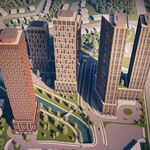A big part of the budget will be blown on a rail-to-rail grade separation somewhere between West Toronto Diamond and Kipling, so there won't be much left over for grade separations. Grade--separating through Streetsville will be a huge obstacle so there's no way we'd get through that within the budget. But we could probably get as far as Cooksville and maybe as far as Erindale in the first phase. A regular off-peak train service from Union to Cooksville could be a useful express alternative to the subway+transitway service.
To save on track costs, the initial phase could include a mix of single and double track on the passenger line, e.g. for 30-minute headways, while protecting for the full double track to be added in future phases.
While work is underway on the $1.2B first phase, planning can continue on the challening subsequent phase that would extend the dedicated passenger tracks through Streetsville.
A sound suggestion - build as much as we can afford quickly, to get whatever level of service CP can allow.
My vote would be to grade separate the two crossings at Erindale Station and Wolfedale - for two reasons
a) they are among the busiest crossings
b) those crossings are the biggest impediment to CP operations, because there is no longer enough room to hold a freight train in the existing triple track between Erindale and Mississauga, given that today's freights are much longer than previously....
Let's say that costs $250M per grade separation, that's $500M total, leaving $700M.
Then build about 5.5 km of triple track from Tenth Line to Streetsville Jct (giving CP a place to park longer trains, and utilising a great deal of roughed-in third track bridgework that doesn't represent any new expense) and 3 kms of track from Mississauga east to Dixie (one new bridge span at Hurontario, and one bridge span over Cooksville Creek).
Dixie and Cooksville Stations do not need new platforms, as both can become island platforms with the third track on the north side. But they will need an underpass to the station.
Surely that can be done for under $700M ? Any money left over can extend third track east from Milton, or add a fourth short passing siding at Meadowvale
That defers the need for any work at Streetsville including any need for a new span over the Credit River. It would be nice to grade separate Mississauga Road, but the above work gives CP two long stretches (10th line to Streetsville, and Erindale to Haines) where a freight train can hold without blocking crossings while GO trains go by. Or, where two freights can pass so that CP only needs one track between Dixie and Milton to run freights in both directions.
I suspect the big operating problem for CP is most likely that any meet between two GO trains forces CP freight to stop, even briefly.... and there is no place to do that any more without blocking crossings.
When I look at Google Maps, it's apparent that so many of the past grade separations have roughed in space for a third (and occasionally fourth) track. The key is to build over those separations, as that can be done without expensive new civil works.
- Paul







